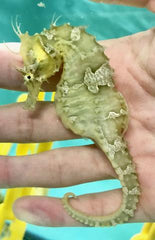How to Sex a Seahorse


Male or Female? How to Sex Your Seahorse
We often get asked how to determine the sex of a seahorse. It is actually quite simple on mature breeding size seahorses if you know what you are looking for. The most distinguishing difference between male and female seahorses is the male broodpouch located beneath his abdomen along the front side of his tail. The male's broodpouch is where the male seahorse fertilizes eggs and carries seahorse fry. You heard it right, male seahorses actually get pregnant and gives birth! This is something unique to the Sygnathid family which includes approximately 36 species of seahorse, pipefish and sea dragons. Pretty amazing! Female seahorses do not have a broodpouch. While the male carries the fry for approximately 14-30 days (this varies for individuals and species) the female is ripening the next egg clutch. The day the male gives birth he often gets pregnant again the same day!
Male Seahorse Examples-Males are more of a "D" shape from the abdomen to tail (see male broodpouch)



Female Seahorse Examples-Female are more of a "P" Shape or bump where the abdomen meets the tail (no broodpouch).



Juvenile Seahorses
While it is generally easy to sex mature breeding size seahorses to the trained eye, juvenile seahorses can be tricky to sex. When a seahorse reaches sexually maturity varies for different species. For us, Erectus seahorses generally reach sexual maturity between 4-6 months of age. Other species such as Australian Barbouri seahorses take longer to develop not reaching sexual maturity until 7-9 months of age. When the male broodpouch begins to developed it can be barely noticeable until he begins courting. When he begins courting with his mate hormonal changes occur causing the male broodpouch to enlarge. Another question commonly ask is at what age can a seahorse breed. A male seahorse can breed as soon as he develops a broodpouch. In general, females can breed around the same age as when the males in a same age batch are developing their broodpouches.
"Late Bloomers"-In most broods or batches of seahorses most individuals sexually mature around the same time. When seahorses begin to sexually mature male broodpouches begin to develop and some females will even start ripening eggs. Occasionally you get some individuals who appear to be a female (no broodpouch) but instead are actually "late blooming" males who have yet to develop a broodpouch. Some late bloomers can take up a year to develop sexually even though the rest of the batch developed much earlier. These individuals are referred to as "late bloomers" meaning they sexually matured much later than the rest of the brood.
Breeding Females
When a female seahorse is ripening eggs they will become quite plump. Mature females ripening large clutches of eggs (300-1000+) will be very bloated in appearance. This is because their ovaries run parallel down each side of their abdomen. Soon after female seahorses transfer eggs to the male broodpouch they will appear very thin in appearance. They will start ripening the next clutch of eggs and fill back out typically within a few days.
Females with Ripened Ovaries


Seahorse Eggs
The left photo below is seahorse eggs that missed the egg transfer. Seahorse eggs are orange in coloration. These eggs are unfertilized eggs since seahorse eggs are fertilized internally in the male broodpouch. It is actually quite common for seahorse pairs to miss the egg transfer. This is common in younger breeding pairs who are still trying to figure out how to successfully transfer eggs. When a seahorse attempts an egg transfer they rise together and line up in the water column where they connect and she deposits her eggs into the males broodpouch. This lining up and courting dance can take lots of practice. Seahorses will rise together many times trying to line up perfectly. This can sometimes take all day in less mature pairs. Eventually, they line up and successfully transfer eggs or they get miss because they are tired from failed repeated attempts or were not lined up well.


Young Juvenile Males (Not Breeding Males)
These are young juvenile males. Their broodpouches have just developed in these photos. Since they are developing and not yet courting or mating their broodpouches are very sunken in. Once they mature, find a mate and begin courting hormonal changes will occur and their broodpouches will enlarge making them easier to sex.



Thank you for visiting our website and reading our article on how to determine the sex of a seahorse. We hope you find this information helpful. If you have any questions or are unsure about the sex of your seahorse feel free to send us a photo of your seahorse at orders@seahorsesavvy.com. We are happy to take a look and try our best to determine the sex of your seahorse.


